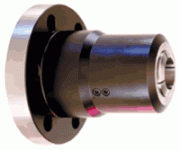RSB-Refugee said:
First let me say all chucks are hazardous to your well being, soft or hard jaws.
Now, here is the reason a small chuck busts your knuckles and a big chuck takes the finger off.

Force = mass X velocity.
Small chucks are safer for two reasons, they have less mass and are slower at the same rpm, compared to larger chucks.
A three inch chuck at 1000 rpm is moving at 8.65 mph. An 8 inch chuck at the same rpm is moving at, 23.78 mph. While bigger is better in many ways, it also equals a lot more hazard to the operator. Don't let these facts lull you into a false sense of security, when working with a small chuck. The small ones are quite capable of doing a lot of harm. Knowledge is power, use it to keep your digits intact.

Tracy
I would never suggest anyone stick their hand in a jaw, or should'nt show the same respect for either type, they are very dangerous, and is why I mentioned what I did. Actually the 2 lathes/jaws I refered to are about the same size. One is aluminum, and the other is steel. Clearly the steel does more damage regardless of size, but the weight plays into it also. I'm not fooled into a false sense, just that one seems safer IMO, from using both. Any fool knows If you stick your hand up in there you risk pulling back a nub regardless of what size or type jaws. Personally I think fatigue is your worste enemy, because that's when slipups take place most often. Spend 10 hours or better a day on a lathe, and that becomes obvious real quick. This likes to take place with me when doing hand work, not often, but enough that I do feel better with the soft jaws in that situation. I do not have this problem when using My tool post, because I am very carefull not to crash the lathes. It is sanding/burmishing/buffing that can cause a slipup with me, and like I mentioned fatigue seems to be the biggest risk, as it is with most equipment and accidents.
The weight/diameter you mentioned acts sort of like a counter weight that adds to the velocity/speed, altough not off balance like one. Depending on gearing They take longer to wind down also due to the weight, just like a big car takes longer to stop due to the momentum created by the mass. Yes I imagine they do more damage, but I was not refering to this. My point was when doing handwork, I prefer soft jaws.
Not that i think there is any disagreement here, but I am not always correct, and man enough to admitt when i realize I'm wrong, but from using both on a daily basis, I stand behind what I said. regardless, I still believe soft jaws are somewhat safer then hard, but that by no meens will keep you totally safe, and severe injury can take place anyway. I have stuck a knuckle up in the hard jaw at alot slower speeds, and it still did way more damage then the soft at higher speeds. Ofcoarse they are also shaped different so the hard jaw cuts/rips flesh alot easier

.
Knowledge is power, is one of the great quotes, and is what makes this forum so wonderfull, that We can share each others passions, and experiences, but I also don't count out the knowledge is gained through personal experiences either, as somethings just have to be learned the hard way IMO (hopefully not the case of getting a hand in the jaws though). I have always learned things best through hands on, with alittle knowledge of what your getting into first.

Altough not fool proof, the soft jaws just better My odds that when/If a slip occurs, I will still be able to do what I love after the fact.
Please be carefull all you brothers in arms

, because regardless of what any of us say on here, this stuff is very dangerous, and should be treated with due respect at all times. There are many other things besides the jaws that can get you when fatigued, or in a rush also. Taking something simular to the measure twice and cut once approach, then applying It to setup, would not be a bad Idea at all IMO, and do think as if you get a hand in those jaws, you might not pull everything back out still intact.
Peace, Greg
